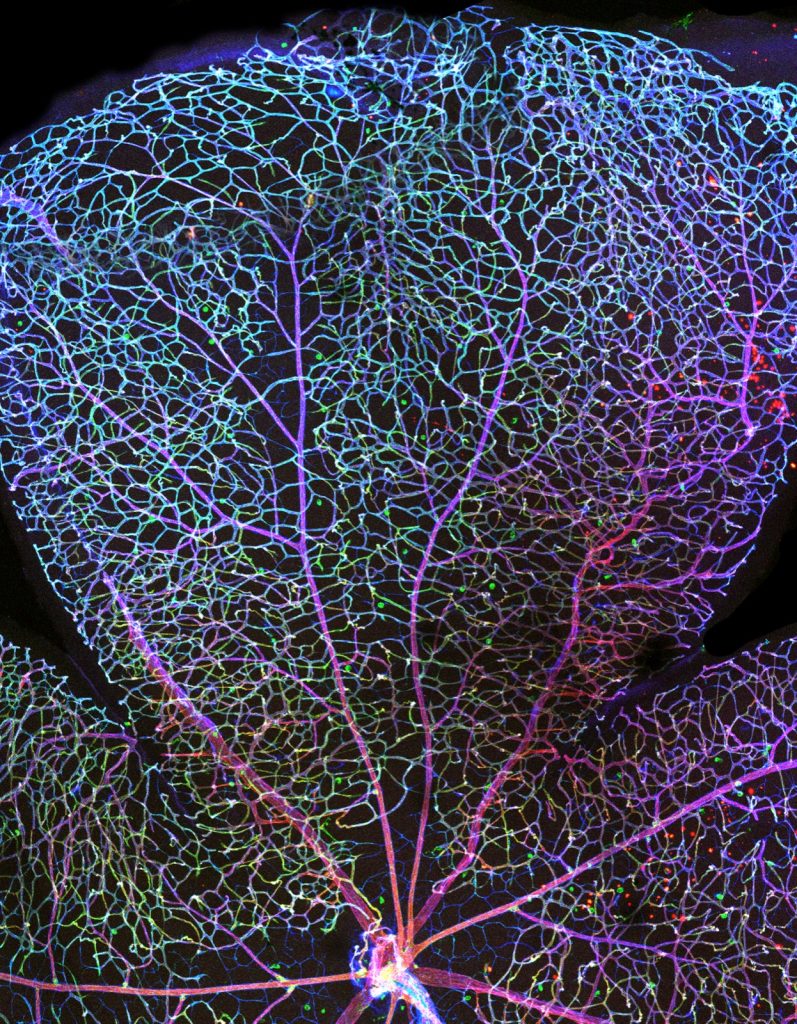Competition between blood pressure and a molecule involved in vascular growth is a turning point in the development of blood vessels
All parts of our bodies are irrigated by blood. This is achieved by a vast network of blood vessels that is formed during development. Now, a new study led by Cláudio Franco, group leader at the Instituto de Medicina Molecular João Lobo Antunes (iMM; Portugal) and recently Group Leader and Vice-Director at the Católica Biomedical Research Center and Associate Professor at the Faculty of Medicine of the Universidade Católica Portuguesa, published today in the scientific journal Developmental Cell*, adds to the puzzle of how the intricate network of blood vessels acquires its complex and efficient structure.
“The network of blood vessels is like a tree: it’s formed by bigger branches that give rise to smaller branches, and cover a large area. In the formation of blood vessels there is a phase in development called sprouting, in which a lot of branches grow. Then, there is a remodeling phase when these branches are organized and refined by “cutting” the branches that are not necessary, much like pruning a tree. This process is essential for the function of the vascular system.” – explains Cláudio Franco, leader of the study. “The growth and remodeling of vascular networks happen because the cells are in constant movement. We discovered a mechanism that defines the orientation of the movement of endothelial cells, the cells that make the interior of blood vessels, helping them selecting the correct path. We like to call it morphogenetic orienteering, as an analogy to the popular guidance sport, only in this case the cells use two different compasses” – continues Cláudio Franco.
“We found that this mechanism is based on competition. Endothelial cells either follow VEGFA, a chemical signal promoting growth of vessels, or the force that the blood exerts on the cells when passing through the vessels. We discovered that when the strongest stimulus is the VEGFA, there is more growth (or sprouting). When the strongest stimulus is the force of the blood flow, there is more vascular remodeling. Remarkably, this is only based on where the cells are going to.” – says Pedro Barbacena, one of the first authors of the study. “As the arteries are formed, there is an increase in the amount of blood going through these blood vessels. The force that the blood flow makes on the vessels’ cells increases, and this changes the vessel development phase from growth to the remodeling, the phase when the structure of the blood vessels gets more and more refined and efficient.”, adds Maria Dominguez-Cejudo, also first author of the study.
These findings are important to understand how blood vessels are formed, but could also be used in the future to develop new therapeutic strategies by affecting the competition between growth and remodelling of blood vessels. Using drugs that alter the blood pressure or the concentration of the growth molecule VEGFA could be a valuable approach in the treatment of vascular malformations and other vascular disorders.
This work was funded by the European Research Council, the “la Caixa” Foundation, the European Commission, H2020-MSCA, the Fondation LeDucq, the Fundação para a Ciência e Tecnologia, the Spanish Ministry of Science and Innovation, and the Fundació la Marató de TV3.

Blood vessels in the retina. Credits: Cláudio Franco
Pedro Barbacena*, Maria Dominguez-Cejudo*, Catarina G. Fonseca, Manuel Gómez-González, Laura M. Faure, Georgia Zarkada, Andreia Pena, Anna Pezzarossa, Daniela Ramalho, Ylenia Giarratano, Marie Ouarné, David Barata, Isabela C. Fortunato, Lenka Henao Misikova, Ian Mauldin, Yulia Carvalho, Xavier Trepat, Pere Roca-Cusachs, Anne Eichmann, Miguel O. Bernabeu, Cláudio A. Franco. Competition for endothelial cell polarity drives vascular morphogenesis in the mouse retina. Developmental Cell 2022